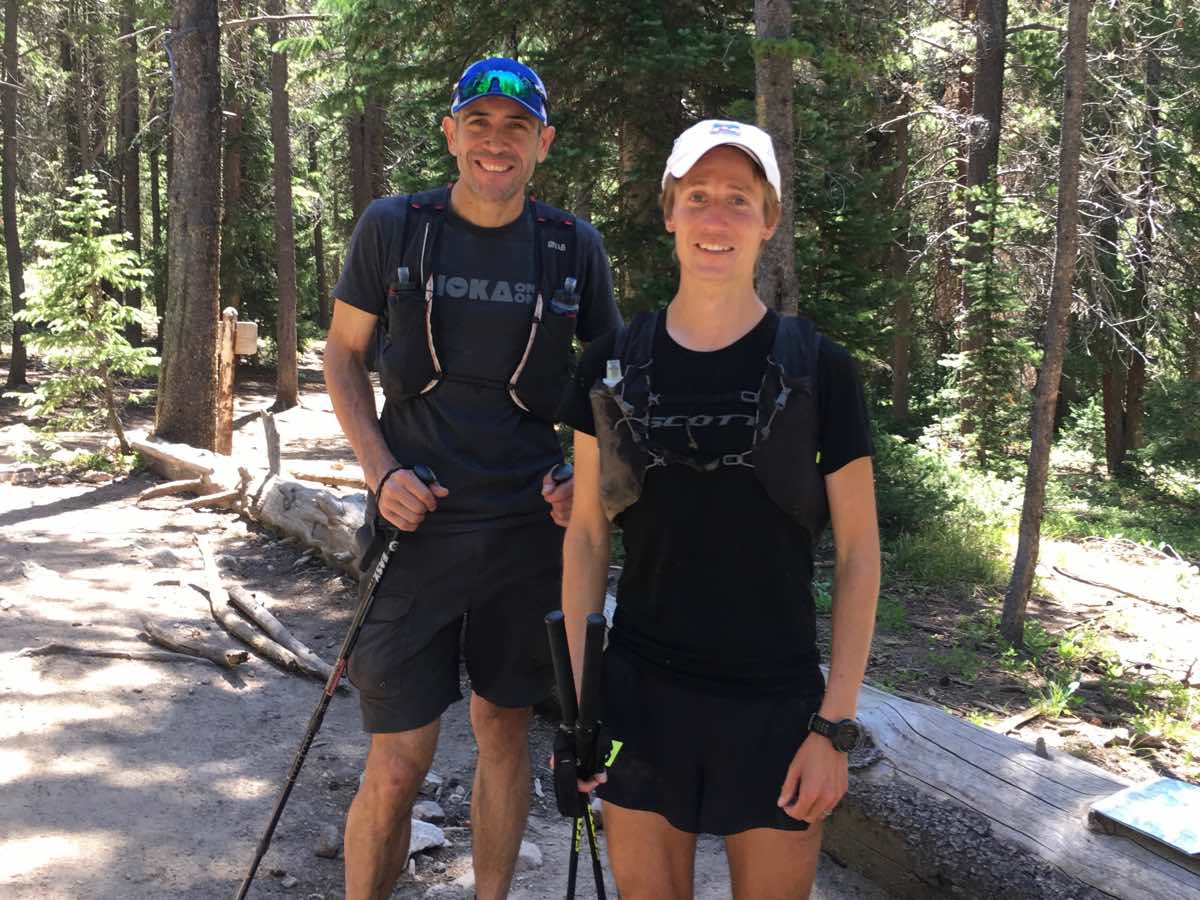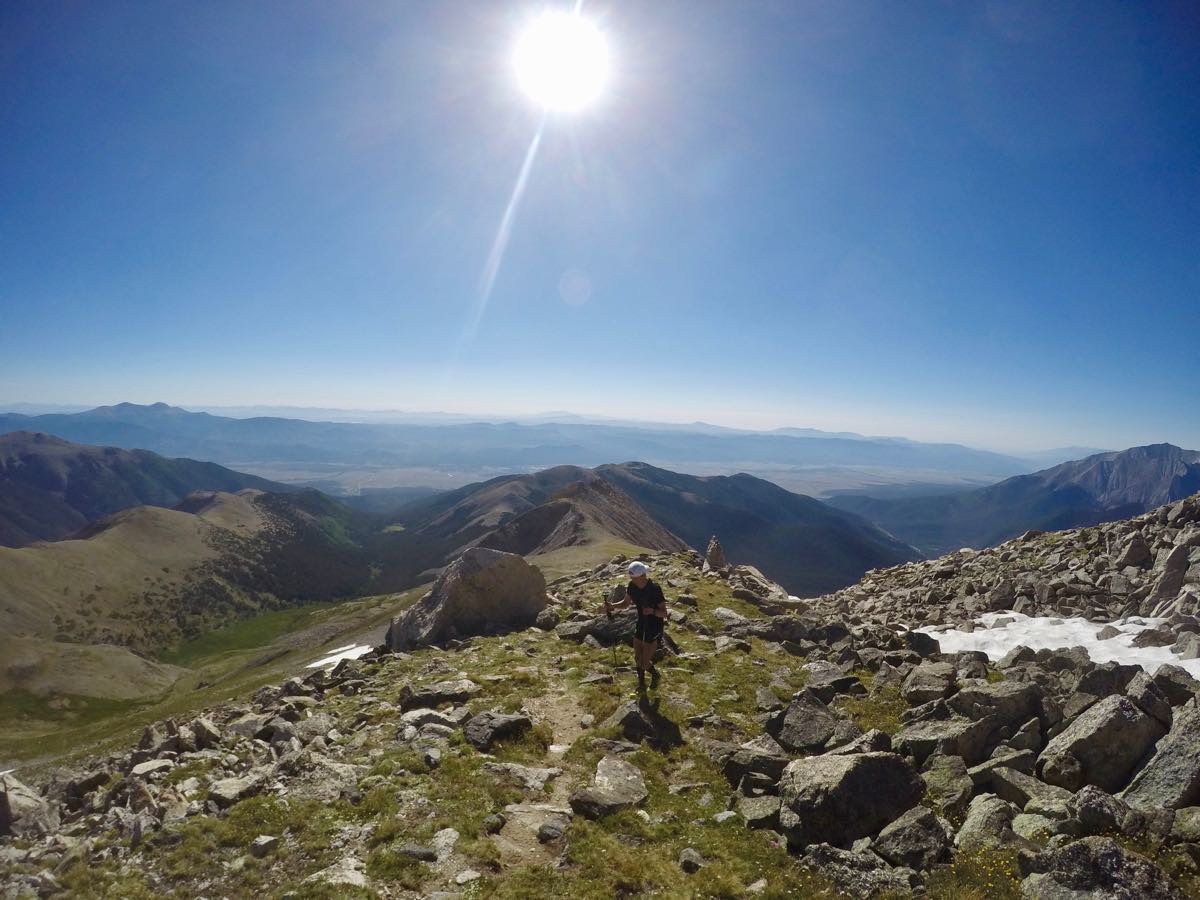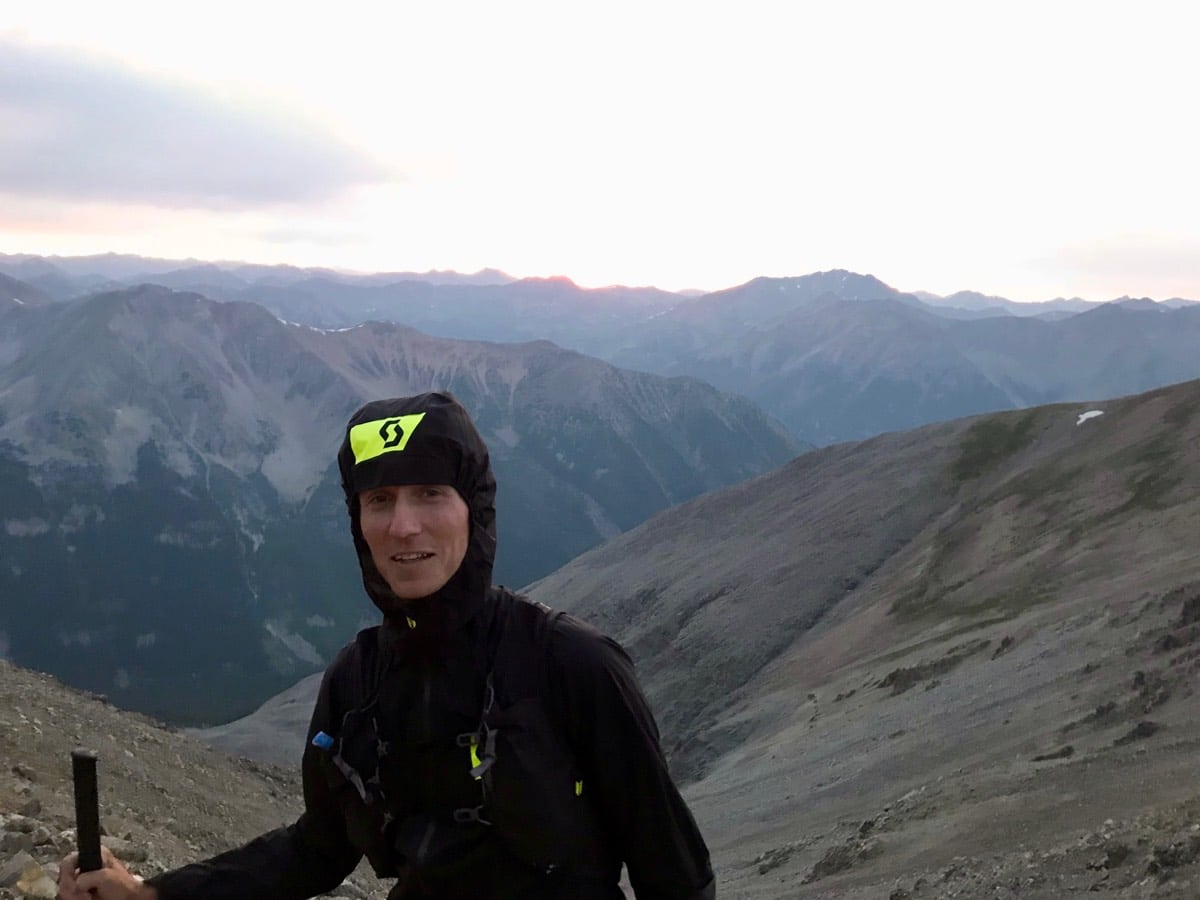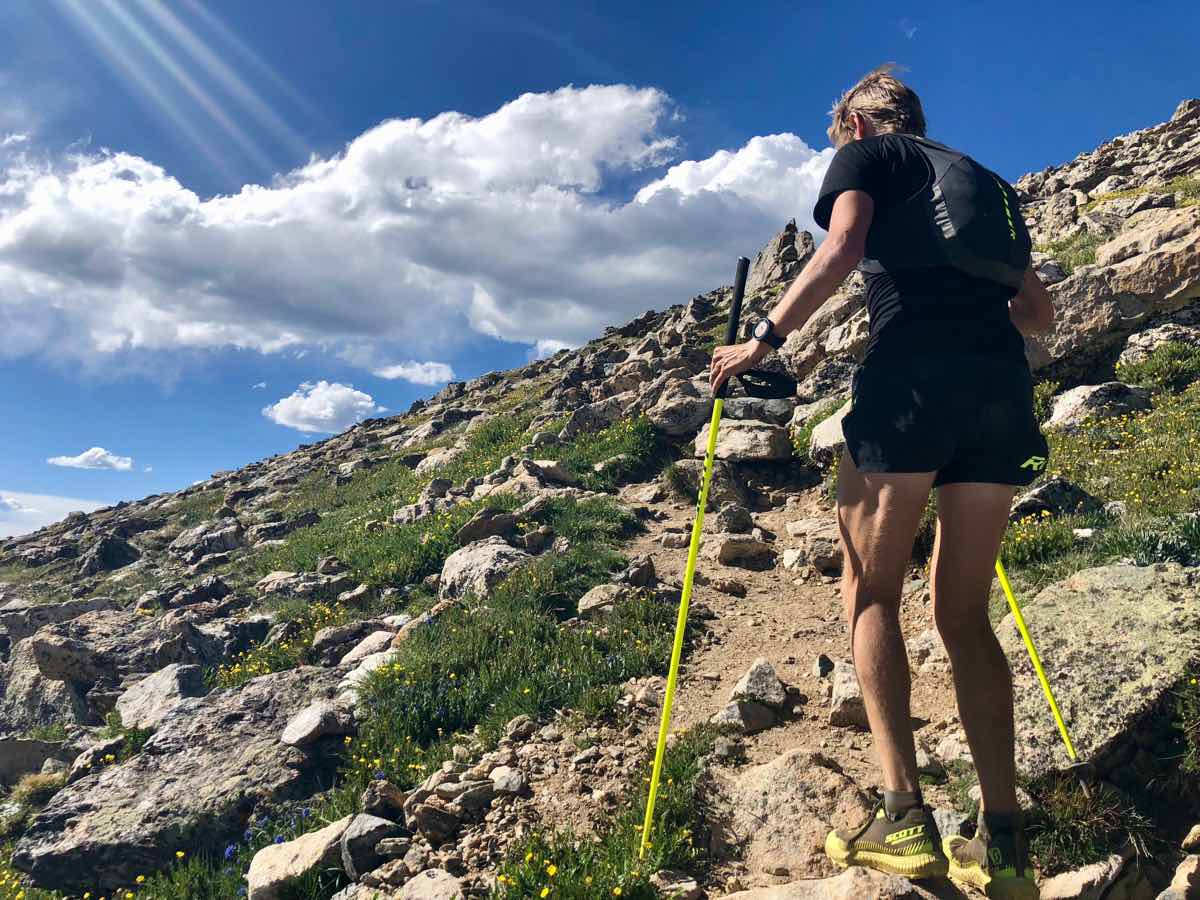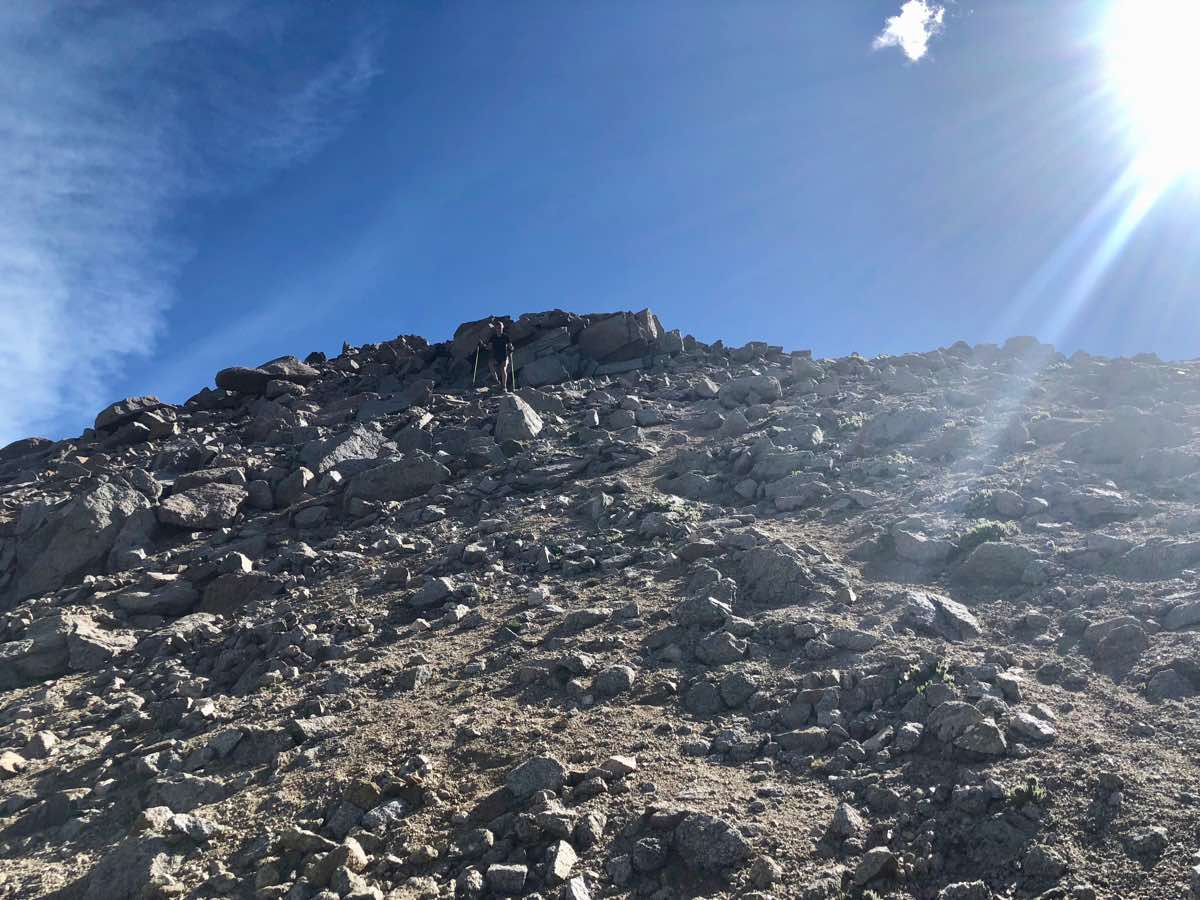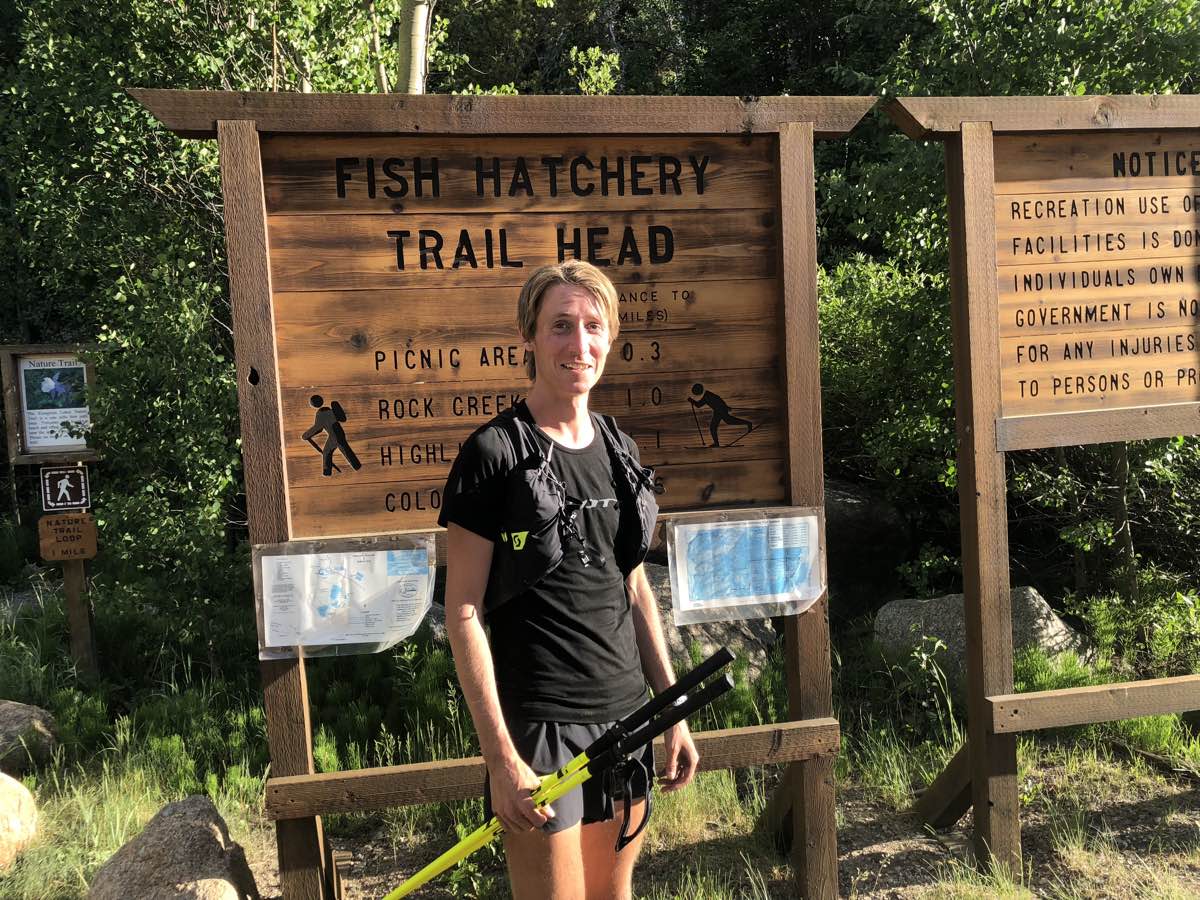From June 27 to 29, 2018, Alex Nichols set a new supported fastest known time on the Nolan’s 14 line in the Sawatch Range of Colorado in 46 hours and 41 minutes, bettering the previous supported record of 47:40 set in 2017 by Iker Karrera.
The Nolan’s 14 line is a link-up of 14 mountains in excess of 14,000 feet elevation. Runners can connect the summits by whatever routes they choose, but routes commonly add up to about 100 miles in length, about 44,000 feet of climbing, and about half off trail.
This is a transcript from a phone interview with Alex three days after his successful attempt. In this interview, Alex talks about how he prepared for Nolan’s, some of the figurative highs and lows of his couple days on the mountains, if he’s happy with his experience, and what’s next in his training and racing.
iRunFar: You’re on vacation in Yosemite National Park, just a couple of days after Nolan’s 14, and you’re hiking.
Nichols: Yeah, I’m here with my brother and his family. We just hiked about 10 miles with some elevation gain. It was interesting, I got to check out the John Muir Trail.
iRunFar: [Laughs] For future FKT attempts?
Nichols: [Laughs] Yeah, I’m already scouting. Right away.
iRunFar: How did the Nolan’s 14 challenge get in your head? You keep creeping up in terms of event distance and general terrain gnarliness.
Alex Nichols: I purposely didn’t try really long stuff early in my career. I think Nolan’s was on my radar because it’s close to where I live [in Colorado Springs, Colorado]. As I was getting more into running, those mountains were my go-to. If we wanted to do a mountain on the weekend, we’d go do Mount Massive. Seeing the growing popularity of Nolan’s put it more on my radar. It’s this amazing challenge and it’s only two hours from my house. That was a good reason to do it. Plus, with UTMB at the end of the summer, I thought, Maybe this is a good training opportunity.
iRunFar: “Training” with a Nolan’s attempt–a lot of people would laugh at the idea.
Nichols: The training leading up to it and then the challenge itself–I am hoping they will help my UTMB race.
iRunFar: What was your training like? There is some real specificity for Nolan’s in terms of knowing the terrain, navigating, being used to high altitude, and more.
Nichols: I had Nolan’s on my agenda since the winter. I wasn’t 100% sure about it but I was always thinking about it. Even early in the year I was trying to get up Pikes Peak at least once a month, just to have that constant exposure to altitude. Once I started training more specifically for the Madeira Ultra SkyMarathon, it was 55k, I still had Nolan’s in mind. Because Madeira has so much elevation change, I thought it was a pretty good lead-up to Nolan’s. From a training standpoint, I was focused on long, steep uphills and altitude since November or December.
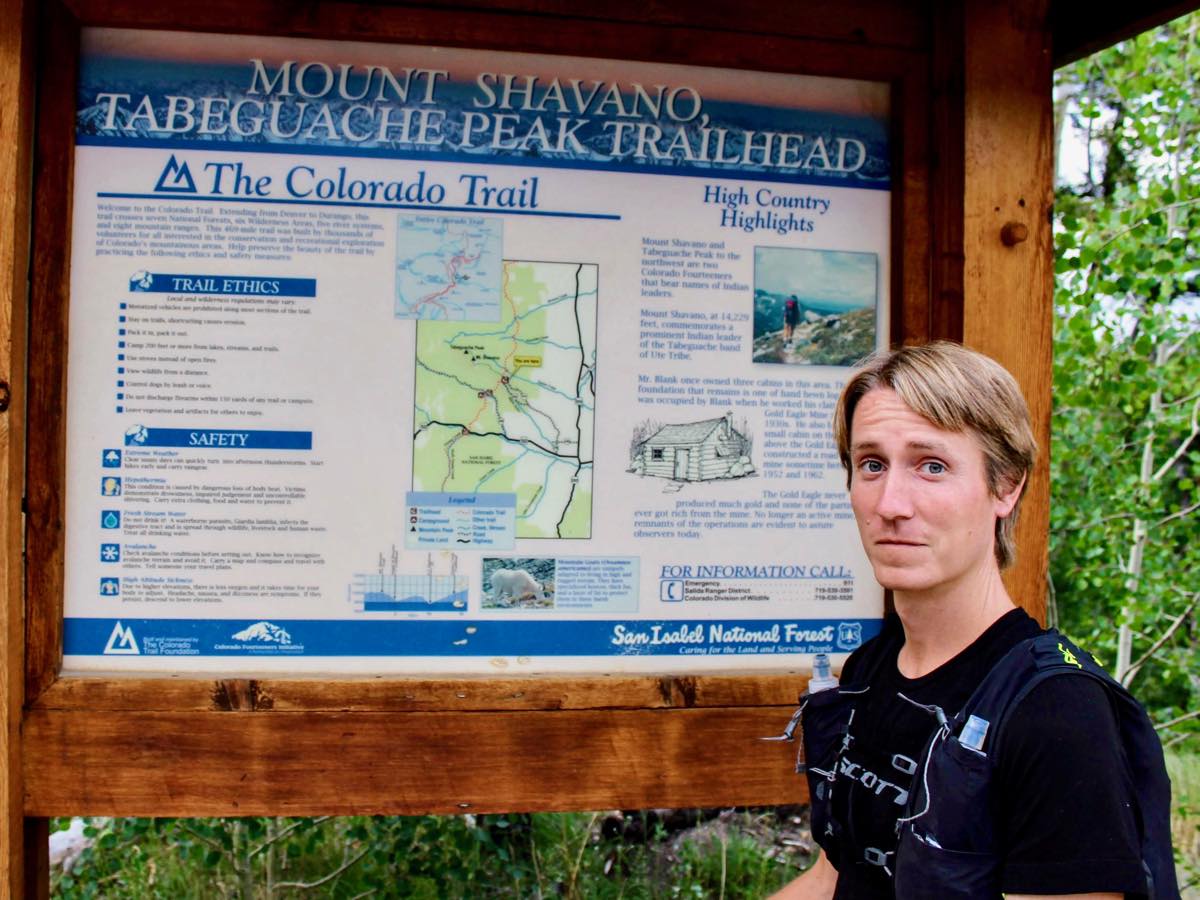
Alex Nichols at the Blank’s Cabin Trailhead before starting his Nolan’s 14 challenge. Photo: Peter Maksimow
iRunFar: You had a hiccup though. You hurt your ankle at Madeira?
Nichols: That definitely made me question the whole Nolan’s thing. I sprained my ankle fairly badly during Madeira, early on in the race. I tried to run through it–initially at full speed–but then it got really bad. I hobbled in. I still managed to finish the race, but afterward I saw the impact the injury had. My ankle was very black and blue, and very swollen for about a week or so. Fortunately, I was able to put weight on it, but it wasn’t very good if I was running downhill. I could still do some flat, easy running if I was careful with the surface. Within about 10 days of Madeira, I was back to feeling good enough that I felt there was a chance I could still do Nolan’s.
iRunFar: You had an interesting approach to route reconnaissance. You backpacked it or fastpacked it?
Nichols: Yeah. In that time between Madeira, which was early June, and when I did my attempt–I was shooting for the full moon at the end of June–I had enough free time to look at the course. I started looking at the chunks of the course to scout, and I found that because the route stays true to the mountains, doing those chunks was going to take too many days and too many car shuttles. I was thinking, I could leave my bike at the trailhead, go run, and then ride back. There were all these shuttle situations. Even in the best-case scenario, I could look at the whole course but it would take me about 10 days.
Then I decided to fastpack the entire route. In four-and-a-half days, I got to see pretty much the whole course. It was an adventure all by itself. It was similar to Nolan’s because it was on the same course, but I was getting to see everything in the daylight and I didn’t have to worry about adding extra time if I wanted to take a break. It was cool.
iRunFar: [Laughs] It was like Nolan’s, but fun.
Nichols: [Laughs] Yeah, in a way. It was surprisingly still really hard. Doing the whole course like that made me really nervous about the idea of doing Nolan’s in less than 60 hours after those 4.5 days. It’s serious, whether you do it slow or fast.
iRunFar: Your planned splits for Nolan’s were unaggressive. I saw them before your attempt and I thought, Wow, he’s going to take it chill and then hammer if he feels good later on. Maybe my assumptions were totally wrong. How did you build your splits and how did you plan going into your attempt?
Nichols: It was basically looking at Andrew Hamilton’s splits when he ran 53 hours or so. Really, like I was saying, when I fastpacked the whole thing, that made me pretty nervous. I was totally and completely fine with just going out there to break 60 hours. To me, 52 was pretty great… I didn’t believe I could run 48. So then it was like, Well, I think I’m better than 60 hours on the dot, so here’s a goal in between. That’s where those splits came from.
iRunFar: You went up Mount Shavano, the first peak, in 1:23 or 1:25. It was a lot faster than your projected split. It just went on from there like that.
Nichols: Yeah, I was pretty surprised by that. Thinking back to my scouting trip, I had a multiday pack on but it was still light enough that I could run a little bit. On that section of the course, I ran 2:10 or something. For the day of my attempt, I was like, Okay, I have to put a little more into it than that. Iker Karrera came through here in 1:40, so I should be somewhere between the two. I put a little bit more effort in, and that little bit more effort turned into 1:25. I also had a surprise situation with my headlamp. I got to the trailhead and realized that it was pretty much empty for batteries because I had accidentally left it on during the travel to the trailhead.
iRunFar: You were starting not long before dark.
Nichols: Yeah, so in addition to the extra effort, I came in with a low headlamp, so I thought maybe I’d get a little bit more done before dark. That was motivating as well. My split from Shavano to Tabeguache [Peak] was also fairly quick. That was definitely intentional because that section was pretty rocky. I didn’t want to do it with a low headlamp or no headlamp, so I tried to do it fairly quickly.
iRunFar: It became dark on your second mountain, and the next couple of mountains were during the night?
Nichols: Yeah. It pretty much got dark during Tabeguache. As a result of the low headlamp, I definitely made some mistakes there. I was kind of in the riverbed. That was frustrating. Then [Mount] Antero, it was dark but the whole south side of the mountain had really nice moonlight. I climbed Antero entirely without my headlamp. The timing of the full moon was huge. That was a really good choice.
The downhill on Antero was fairly dark once I got into the woods, which was frustrating because I couldn’t see very far ahead of me. It was a rocky road. All of these things which felt to me like I was screwing up and going slow–I had wanted to run the downhill of Antero pretty quickly. Then suddenly I was [still] four hours ahead of my schedule.
iRunFar: To what you’d attribute your speed [despite those issues]? You were going so much faster than what you thought you would. Did you peak your fitness perfectly? Was the fastpacking trip at altitude with a heavy pack good training?
Nichols: The fastpacking trip definitely helped. I haven’t done that sort of long training before. I have focused on miles and vertical in training before, but I had never done days where I’d gone slow for 12-hour days. I felt great when I came home. I kept up the steep running between that and doing the Nolan’s route. I was also in really good shape for Madeira, even though the race didn’t go well. I think that fitness carried over because it was only a month later.
iRunFar: Did I hear you had a wildlife encounter coming off of [Mount] Princeton? Was it still dark?
Nichols: I wound up doing all of Princeton by moonlight.
iRunFar: That’s amazing.
Nichols: [Laughs] Trust me, it’s not amazing. It’s terrible. When I got on–I think it’s an old mining trail that intersects with the Colorado Trail–I heard a rustling near me. I looked over and it was a cinnamon-colored black bear with her cubs huddled over. They were clearly as surprised as I was so I banged my trekking poles together a little bit and they ran away. The sun rose and I had a really fun time on the Colorado Trail, running in the daylight. That was a nice change of pace, to be on trail.
iRunFar: Joe Grant was out there over the same days working on his unsupported FKT. Your trackers appeared to overlap on Mount Yale. Did you talk? What did you say? What happened?
Nichols: We grunted at each other and then we kept going [laughs]. No, it was really surprising. It was on one of those sections where you’re still off-trail. You’re traversing before dropping down into the woods. Sure enough, Joe was on the exact same line as me even though he was coming from the different direction. That was really cool. It’s such a random route and there were all these variables, but we were still on the same line.
At that point, I don’t think either of us was feeling that great. We had a mutual nausea going on, so we talked about possible effects and ways to prevent it. He said he had just taken a nap coming down [Mount] Columbia because he was getting kind of delirious in the heat. So he laid down on the mountain and slept for an hour. To hear later on that he ended up rallying and having such a good final stint was awesome. It was a good encounter. We were both feeling similar things and it was good to commiserate.

Joe Grant (left) and Alex meeting up on Mount Yale during their respective Nolan’s 14 outings. Photo: Dan Vega
iRunFar: Mount Yale was mountain number five in the direction that you were traveling. You were already feeling poorly?
Nichols: Yeah. I think it was the repeated trips to higher altitude. It was classic altitude-sickness symptoms–a bit of nausea, headache. At that point it wasn’t that bad. I was still eating and drinking pretty well. It was surprising, though, I didn’t see that part coming.
iRunFar: In the second night, you had more issues with nausea over drinking a 5-Hour Energy. You were able to put yourself back together both times. Nausea is an issue a lot of people struggle to bounce back from.
Nichols: The 5-Hour Energy was a mistake. Don’t try anything new on race day, right [laughs]? Of course, I’ve never had a 5-Hour Energy and the one time I try it is on a completely empty stomach on the top of Mount Belford just before staying above tree line for another hour. It made me feel super-sick.
I figured it out later, but for me the nausea was induced by low calories. I wasn’t eating enough, but then I’d get nausea and I wouldn’t want to eat. Looking back on it now, I can’t believe how little I ate. I would eat one 200-calorie bar for three hours. I didn’t want to eat.
The times that I eventually got [calories] back [in] were at the crew stops where I sat down and I didn’t care about the time anymore. I sat there and took the time to get down some food. That would help me feel better, and once I was feeling better I could eat more food. I was rushing through stuff on this attempt and I definitely should have been eating more early on.
iRunFar: Did you have to enter the pain cave to get through it, or were you always staying on the right side of discomfort?
Nichols: Probably from 3:00 a.m. on Friday morning[, the final morning,] until maybe 10:00 a.m., those were some of the lowest lows I’ve ever been through in any running situation. The lack of sleep really hit at that point. It was the morning of my second night. We were going up La Plata [Peak], which is one of the easiest mountains of the entire course. I had been looking forward to it because it was so easy, but I was just crawling, almost falling asleep on my feet. The trail is so simple that I’d kind of zone out and then wake up realizing I had closed my eyes. Almost at the summit of La Plata–because there are false summits–so I was at one of the last ones and I pretty much sat down. I later told David [Hedges], who was running with me there, that if there was a chance to drop out then, I would have. But there was no other way down. Eventually, I turned around with the help of daylight and some more food, but it was super-miserable.
iRunFar: Did you ever question it? Did you go in expecting to enjoy yourself or did you anticipate that it would really suck at some point?
Nichols: I knew that it was going to be rough because I had seen the course. Even then, I got to a point where it was so terrible that the motivation definitely dropped off. I didn’t care about being under 60 hours or whatever. You just want to be done and it doesn’t matter where you are or what you’re doing. You want it to be over.
iRunFar: For much of your attempt, you were faster than Iker Karrera’s splits. Were you thinking about the record? Did that come into play?
Nichols: When I was that far ahead of my own splits–I had planned to finish the route in 52 hours and I didn’t know what Iker’s splits were. But when I was four hours ahead and realized I was close to 48, yeah, definitely. I had to keep second-guessing it. I was like, What time of day is it? I’m not good at math to begin with, so if you add in 40 hours of not sleeping [it was hard to calculate if I was on record pace]. As soon as I saw my crew at Avalanche Trailhead, that’s when I knew I was close to the FKT. I was feeling really good, I thought I might as well try to go after it.
iRunFar: It got a little close at the end as to whether you’d finish over or under the record.
Nichols: Yeah, I rallied amazingly well after feeling so bad on La Plata, which was mountain number 12. Then, once we got to the top of Mount Elbert, we got there faster than what my goal was. I knew I was within striking distance of the record. I had not done Elbert during my scouting trip because I got rained out. I did not know the best way down. That resulted in a slow and frustrating scree field downhill with way too much second-guessing. I’d be going down one line that probably would have worked and I’d be like Oh, I’m going to go to the right instead. But that wasn’t any better, so I’d go back to the left. By the time those shenanigans were done and I got back to the road, I looked to David and said, “Oh no, I don’t think we’re going to do this.” From then on, it felt like a sprint finish to get up and over Mount Massive, the last mountain.
iRunFar: I haven’t looked super-closely at the splits, but some people have very fast final descents. They’ll be coming down Mount Shavano in under an hour or something. But I don’t think anyone has closed Nolan’s–both the final climb and descent–as fast as you. You must have been really motivated.
Nichols: Yeah, I was out there for so long and had done so much. After doing the math, I realized that if I maintained the pace I had on Elbert, I’d miss the record by 10 minutes. Losing the record by that little would be so frustrating.
iRunFar: You’d recount all the places where you could have gotten 10 minutes back.
Nichols: I was already doing that in my head [laughs]. I shouldn’t have sat so long at Winfield. I tied my shoes three times too many. I didn’t want to be on the wrong side of close.
iRunFar: Full disclosure: I [Meghan Hicks] got to accompany you over the last mountain. When you arrived at the bottom between mountains 13 and 14, you had about 4:30 to finish under the record. You said, “What are the chances I can do this?” I didn’t say anything at first because you’d taken a long time on Mount Elbert [laughs]. You asked again, so I said, “Well, it’s possible if you feel good enough to work hard.” And then you just started hammering. I was thinking, Wow, if he holds this pace for even half the ascent, he’ll have recovered the lost time from Elbert, and he’ll be just fine. But you didn’t just hold it for half the ascent. You held it for the full ascent and the descent.
Nichols: That little bit of hope was the motivation I needed. If I had a chance of finishing under the record, I had to give it everything.
iRunFar: You had 4.5 hours until the record time, and you took basically 3.5 hours. You came into the finish at the Fish Hatchery trailhead at 46:41, improving the record by 59 minutes. What was going through your head when you finally got to stop?
Nichols: Relief. And happiness that I was able to get under the record by that much. I wish things had gone better, but I think everyone who has ever tried Nolan’s has had something go wrong along the way. Even though in my mind I’m like, Oh, I could’ve done all these different things better and run 45 hours or something, a huge part of the challenge is still dealing with all those problems. I’m feeling better about it now. But when I finished, I was happy but it was like, I could’ve gone faster.
iRunFar: Do you think it’s a reasonable assertion to have had a more problem-free 46.5 hours? Sure, maybe we all have one perfect 100 miler in our lives. But is that even possible in Nolan’s?
Nichols: Probably not. That’s a hard thing to realize. Sure, I had navigation problems that slowed us down, but I also had unbelievably perfect weather and a full moon. I would be really surprised if anyone came away from a Nolan’s attempt thinking, That was okay, I did everything right. That was my best possible performance. Maybe that’s why it’s so hard for people to just walk away from it.
iRunFar: You’re running UTMB later this year. Basically, you’re planning to take all of this volume from the last month or two and get into some specific UTMB training? How will you leverage this going forward?
Nichols: I think it will be really beneficial to have this ability to cope with repeated climbs and descents the way Nolan’s has. That’s what UTMB is all about: long uphill, long downhill, over and over. Now I have more experience going through the night. I’ve done Run Rabbit Run 100 Mile, but that was my only other experience of going through the night. I’ll get more specific going into UTMB. More running, less hiking.
iRunFar: You’re going to have to actually do the running motion again. But at least you won’t need a headlamp for nighttime travel. You have a new talent [laughs].
Nichols: [Laughs] Yes, I have a secret weapon now.
iRunFar: [Laughs] Night vision. I almost forgot, you said you hallucinated!?
Nichols: A ton. It was mainly people. I kept seeing a guy bent over tying his shoe on the trail. I’d get within five feet of him and it’s just a rock. No matter the hallucination, it was always just a rock. It was getting very frequent in the last eight hours or so. It was happening to me every 30 minutes or so. It actually almost caused a problem on Elbert. I thought I saw people hiking a switchback on the mountain in front of me. I was like, “I see people, so I’ll head that way.” Then I get there, and there’s definitely no trail and no people. Fortunately it was still the direction in which I wanted to go.
iRunFar: Congratulations on your supported Nolan’s 14 FKT!
Nichols: Thanks.
